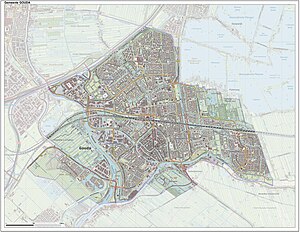This article needs additional citations for verification. (June 2016) |
Gouda | |
|---|---|
City and municipality | |
Panoramic view of the city City centre Historic town hall Port | |
 Location in South Holland | |
| Coordinates: 52°0′40″N 4°42′40″E / 52.01111°N 4.71111°E | |
| Country | Netherlands |
| Province | South Holland |
| Government | |
| • Body | Municipal council |
| • Mayor | Pieter Verhoeve (SGP) |
| Area | |
| • Total | 18.11 km2 (6.99 sq mi) |
| • Land | 16.50 km2 (6.37 sq mi) |
| • Water | 1.61 km2 (0.62 sq mi) |
| Elevation | 0 m (0 ft) |
| Population (January 2021)[3] | |
| • Total | 73,681 |
| • Density | 4,466/km2 (11,570/sq mi) |
| Demonym | Gouwenaar |
| Time zone | UTC+1 (CET) |
| • Summer (DST) | UTC+2 (CEST) |
| Postcode | 2800–2809 |
| Area code | 0182 |
| Website | gouda.nl |

Gouda (Dutch pronunciation: [ˈɣʌudaː] ) is a city and municipality in the west of the Netherlands, between Rotterdam and Utrecht, in the province of South Holland. Gouda has a population of 75,000 and is famous for its Gouda cheese, stroopwafels, many grachten, smoking pipes, and its 15th-century city hall. Its array of historic churches and other buildings makes it a very popular day-trip destination.
In the Middle Ages the Van der Goude family founded a settlement at the location of the current city and built a fortified castle alongside the banks of the Gouwe River, from which the family and the city took their names. Locals long called the settlement Ter Goude, or Tergou or Tergouw for short.[4] The area, originally marshland, developed over the course of two centuries.[timeframe?] By 1225, a canal was linked to the Gouwe and its estuary became a harbour. In 1272 Floris V, Count of Holland granted the city city rights.
- ^ "Kerncijfers wijken en buurten 2020" [Key figures for neighbourhoods 2020]. StatLine (in Dutch). CBS. 24 July 2020. Retrieved 19 September 2020.
- ^ "Postcodetool for 2801JM". Actueel Hoogtebestand Nederland (in Dutch). Het Waterschapshuis. Archived from the original on 21 September 2013. Retrieved 22 July 2013.
- ^ "Bevolkingsontwikkeling; regio per maand" [Population growth; regions per month]. CBS Statline (in Dutch). CBS. 1 January 2021. Retrieved 2 January 2022.
- ^
Abels, P. H. A. M., ed. (200). Duizend jaar Gouda: een stadsgeschiedenis. Verzameling bijdragen: Historische Vereniging Die Goude, volume 30 (in Dutch). Hilversum: Uitgeverij Verloren. p. 15. ISBN 9789065507174. Retrieved 9 November 2023.
Gouda werd vanouds 'Ter Goude' genoemd, of kortweg 'Tergou'. Deze naam betekent 'stad aan de Goude, dat wil zeggen: Gouwe'. [...] In het Nederlands bleef de naamsvorm 'Ter Goude' nog tot ver in de vroegmoderne tijd in gebruik.






